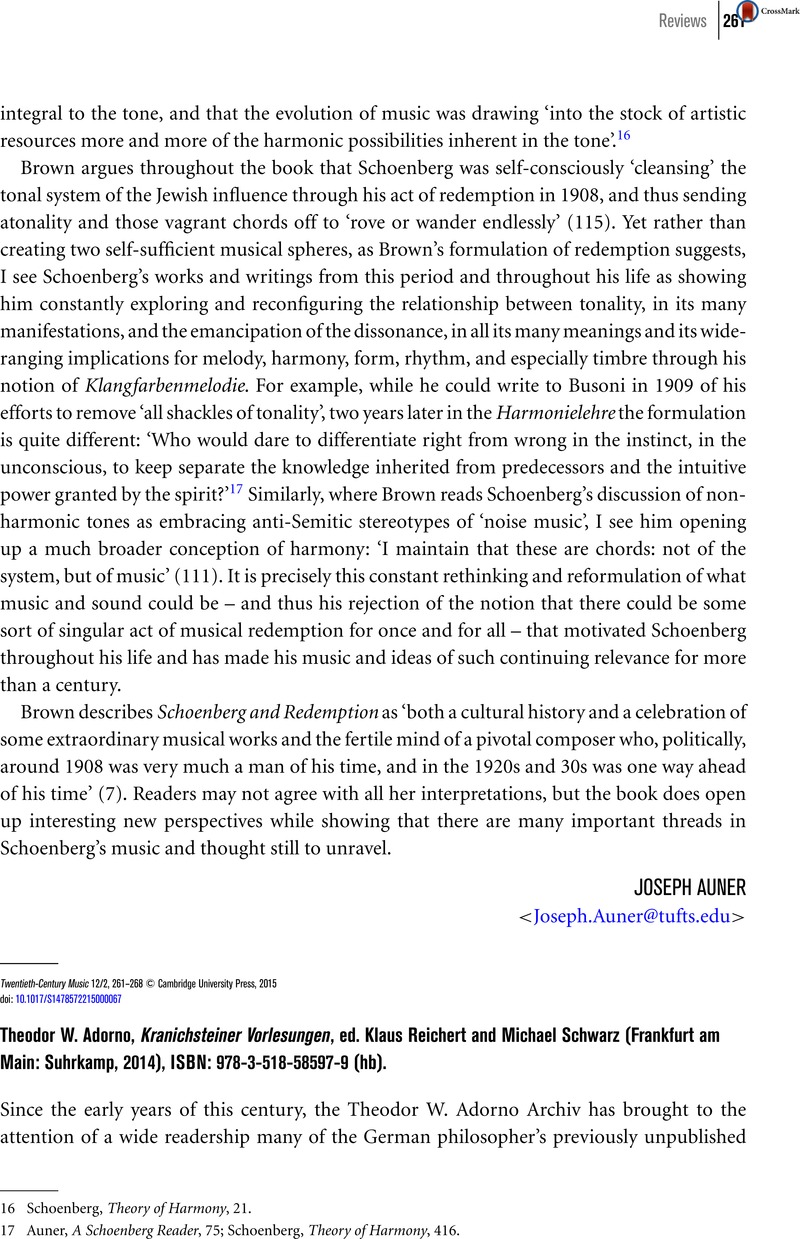Article contents
Theodor W. Adorno, Kranichsteiner Vorlesungen, ed. Klaus Reichert and Michael Schwarz (Frankfurt am Main: Suhrkamp, 2014), ISBN: 978-3-518-58597-9 (hb).
Published online by Cambridge University Press: 26 August 2015
Abstract

- Type
- Reviews
- Information
- Copyright
- Copyright © Cambridge University Press, 2015
References
1 I would like to thank Brent Waterhouse for translating this review. The editors would like to thank Mirjam Frank for translating into English the quoted excerpts from Adorno's writings.
2 Beethoven: The Philosophy of Music (Stanford: Stanford University Press: 1998); Towards a Theory of Musical Reproduction: Notes, a Draft and Two Schemata, ed. Henri Lonitz (Cambridge: Polity Press, 2006); Current of Music: Elements of a Radio Theory, ed. Robert Hullot-Kentor (Cambridge: Polity Press, 2009).
3 ‘Kriterien der neuen Musik’, in Adorno, Gesammelte Schriften, vol. 16, ed. Rolf Tiedemann (Frankfurt am Main: Suhrkamp Verlag, 1978), 170–228; published in English as ‘Criteria of New Music’, in Sound Figures, trans. Rodney Livingstone (Stanford: Stanford University Press, 1999), 145–86; ‘Vers une musique informelle’, Gesammelte Schriften 16, 493–540; published in English (with the original French title) in Quasi una Fantasia: Essays on Modern Music, trans. Rodney Livingstone (London: Verso, 1998), 269–322; Funktion der Farbe in der Musik, in Darmstadt Dokumente I, ed. Heinz-Klaus Metzger and Rainer Riehn (Munich: edition text+kritik, 1999), 263–312.
4 The passages found in two letters written by Adorno to Steinecke in 1956, quoted by the editors in Kranichsteiner Vorlesungen, 581–2.
5 ‘das von Schönberg erarbeitete Material ist heute in einem weitem Maß Gemeingut jedenfalls der überhaupt ernst zu nehmenden jüngeren Komponisten geworden, aber um den Preis, daß es die Erfahrungen verloren hat, um die es einmal gemacht worden ist: daß es, vulgär gesprochen, zu billig geworden ist; daß diese Mittel also weitgehend des Sinnes begeben haben, den sie an ihrem Ursprung einmal gehabt haben’ (Kranichsteiner Vorlesungen, 12). See also ‘Das Altern der Neuen Musik’ (1954), in Gesammelte Schriften; published in English as ‘The Aging of New Music’, trans. Robert Hullot-Kentor and Frederic Will, in Essays on Music, ed. Richard Leppert (Berkeley: University of California Press: 2002), 181–202. At the beginning of the third lesson, Adorno adds a long comment on the criticism that this essay received (Kranichsteiner Vorlesungen, 85–91).
6 In the critical apparatus, the editors also reproduce his notes to the degree to which they have been conserved.
7 Kranichsteiner Vorlesungen, 52. See also Borio, Gianmario, ‘Work Structure and Musical Representation: Reflections on Adorno's Analyses for Interpretation’, Contemporary Music Review 26/1 (2007), 53–75Google Scholar.
8 Kranichsteiner Vorlesungen, 25.
9 Dahlhaus, Carl, ‘Musik und Jugendstil’, in Gesammelte Schriften, vol. 6: 19. Jahrhundert III, ed. Danuser, Hermann (Laaber: Laaber, 2003), 511–23Google Scholar; Brinkmann, Reinhold, ‘On the Problem of Establishing Jugendstil as a Category in the History of Music with a Negative Plea’, Miscellanea Musicologica 13 (1984), 19–48Google Scholar.
10 Samson, Jim, Music in Transition: A Study of Tonal Expansion and Atonality, 1900–1920 (London: Dent, 1977)Google Scholar.
11 ‘der Versuch, aus dem Umkreis der bürgerlich-konventionalisierten Formen auszubrechen, zugleich aber doch in dem Umkreis der von der bürgerlichen Welt vorgezeichneten Formen sich zu halten’ (Kranichsteiner Vorlesungen, 25).
12 English translation from Aesthetic Theory, trans. Robert Hullot-Kentor (New York: Bloomsbury Academic, 2013), 366. In the original German, the passage appears as: ‘Jugendstil ist, wie der Name verrät, die in Permamenz erklärte Pubertät: Utopie, welche die eigene Unrealisierbarkeit diskontiert’; Ästhetische Theorie, Gesammelte Schiften, vol. 7, ed. Rolf Tiedemann (Frankfurt am Main: Suhrkamp, 1970) 404.
13 Kranichsteiner Vorlesungen, 45.
14 ‘Zur Funktion des Kontrapunkts in der neuen Musik’, in Gesammelte Schriften, vol. 16, 145–69. Appears in English as ‘The Function of Counterpoint in New Music’, in Sound Figures, trans. Rodney Livingstone (Stanford: Stanford University Press, 1999), 123–44.
15 See Stephan, Rudolf, ‘Schönbergs Entwurf über Das Komponieren mit selbständigen Stimmen’, Archiv für Musikwissenschaft 29/4 (1972), 239–46CrossRefGoogle Scholar; Schoenberg, Arnold, Coherence, Counterpoint, Instrumentation, Instruction in Form, ed. Neff, Severine (Lincoln: University of Nebraska Press, 1994), 64–77Google Scholar.
16 ‘The independence of development in a voice merely consists of following the requirements and possibilities of its motive’ (Schoenberg, Coherence, Counterpoint, Instrumentation, Instruction in Form, 67; emphasis in original). The motive's centrality allows Adorno to follow the evolution of the single voices as a consequence of ‘developing variation’ and to consider ‘durchbrochene Arbeit’, the distribution of thematic material among different voices, to be the technique that governs Schoenberg's counterpoint as a whole.
17 ‘die Form [ist] nichts anderes [. . .] als die Entfaltung der impliziten kontrapunktischen Möglichkeiten, die in einem Thema und seiner oder seinen prinzipalen Gegenstimmen eigentlich angedeutet [sind]’ (Kranichsteiner Vorlesungen, 163).
18 Borio, Gianmario, ‘Dire cela, sans savoir quoi: The Question of Meaning in Adorno and in the Musical Avant-Garde’, in Apparitions: New Perspectives on Adorno and Twentieth-Century Music, ed. Hoeckner, Berthold (New York: Routledge, 2006), 41–67Google Scholar.
19 Kurth, Ernst, Grundlagen des linearen Kontrapunkts: Bachs melodische Polyphonie (1917) (Bern: Krompholz, 1956), 2Google Scholar. Kranichsteiner Vorlesungen 138, 202.
20 Compare Kranichsteiner Vorlesungen, 157.
21 Kurth, Grundlagen, 100.
22 Kranichsteiner Vorlesungen, 224.
23 See Stockhausen, Karlheinz, ‘Zur Situation des Metiers (Klangkomposition)’ (1954), in Texte zur elektronischen und instrumentalen Musik, vol. 1, ed. Schnebel, Dieter (Köln: DuMont 1963), 45–61Google Scholar. Schaeffer, Pierre, Traité des objects musicaux (Paris: Seuil, 1966), 232–43Google Scholar.
24 Kranichsteiner Vorlesungen, 459.
25 Kranichsteiner Vorlesungen (MK 275). See similar passages in Wellesz, Egon, Die neue Instrumentation, vol. 2 (Berlin: Hesse, 1928), 15Google Scholar.
26 ‘Es gibt keinen Takt mehr, der nicht ebenso als Klang gehört wäre, wie er komponiert ist’ Kranichsteiner Vorlesungen (MK 286).
27 Philosophie der neuen Musik (Frankfurt am Main: Suhrkamp, 2003), 174–6; ‘On Some Relationships between Music and Painting’, trans. Susan Gillespie, Musical Quarterly 79 (1995), 66–79; ‘Die Kunst und die Künste’, in Gesammelte Schriften vol. 10, 432–53.
- 1
- Cited by




